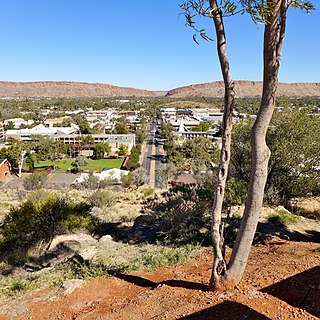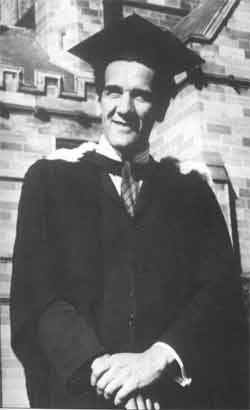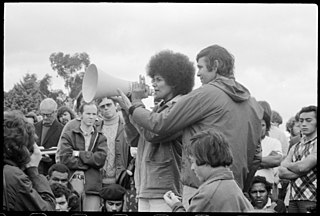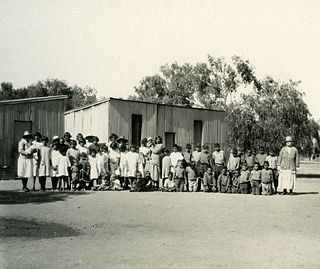Related Research Articles

Alice Springs is a town in the Northern Territory, Australia; it is the third-largest settlement after Darwin and Palmerston. The name Alice Springs was given by surveyor William Whitfield Mills after Alice, Lady Todd, wife of the telegraph pioneer Sir Charles Todd. Known colloquially as The Alice or simply Alice, the town is situated roughly in Australia's geographic centre. It is nearly equidistant from Adelaide and Darwin.

Charles Nelson Perkins, usually known as Charlie Perkins, was an Aboriginal Australian activist, soccer player and administrator. It is claimed he was the first known Indigenous Australian man to graduate tertiary education. He is known for his instigation and organisation of the 1965 Freedom Ride and his key role in advocating for a "yes" vote in the 1967 Aboriginals referendum. He had a long career as a public servant.
John Kundereri "Jumbana" Moriarty is an Aboriginal Australian artist, government advisor and former soccer player. He is also known as founder of the Balarinji Design Studio, for painting two Qantas jets with Aboriginal motifs.
Charles Duguid was a Scottish-born medical practitioner, social reformer, Presbyterian lay leader and Aboriginal rights campaigner who lived in Adelaide, South Australia for most of his adult life, and recorded his experience working among the Aboriginal Australians in a number of books. He founded the Ernabella mission station in the far north of South Australia. The Pitjantjatjara people gave him the honorific Tjilpi, meaning "respected old man". He and his wife Phyllis Duguid, also an Aboriginal rights campaigner as well as women's rights activist, led much of the work on improving the lives of Aboriginal people in South Australia in the mid-twentieth century.

Gordon Briscoe AO was an Aboriginal Australian academic and activist. In 1997, he was awarded a PhD from the Australian National University. He was also a soccer player.
Wally McArthur was an Aboriginal Australian rugby league footballer and track and field athlete. In 2008, the centenary of rugby league in Australia, he was named in the Aboriginal Australian rugby league team of the Century.

Lewis William Arthur O'Brien, known as Yarlupurka, usually known as Uncle Lewis O'Brien, is an Aboriginal Australian elder of the Kaurna people.

The Bungalow was an institution for Aboriginal children established in 1914 in Alice Springs in the Northern Territory of Australia. It existed at several locations in Alice Springs, Jay Creek and the Alice Springs Telegraph Station.

Topsy Smith was an Arabana pioneer of Central Australia in the Northern Territory. She spent her life caring for Indigenous children at an institution known as The Bungalow in Alice Springs.
Richard W. Bray, known as Richie Bray, was an Aboriginal Australian rules footballer who played for the Port Adelaide Football Club.

Percy McDonald Smith (1903-1982) was a priest in the Anglican Church of Australia. He was the first Archdeacon of the Northern Territory, and the founder of St John's Hostel in Alice Springs and St Francis House, a home for Aboriginal children in Adelaide.
Malcolm Cooper was an Aboriginal Australian Australian rules footballer who played for Port Adelaide during the 1950s, and a social activist.
Phyllis Evelyn Duguid, née Lade, was an Australian teacher and Aboriginal rights and women's activist, who was highly regarded for her long-term commitment to those she saw as members of an underclass in society. She was married to, and often worked alongside, Charles Duguid, medical practitioner and Aboriginal rights campaigner, the couple leading much of the work on improving the lives of Aboriginal people in South Australia in the mid-twentieth century. She founded the League for the Protection and Advancement of Aboriginal and Half-Caste Women, which later became the Aborigines' Advancement League of South Australia (AALSA).
William Leonard Espie was the highest ranking Aboriginal person to serve on any Australian police force; he was, at one point the Chief Inspector in the NSW Police Force. He is remembered as a "Centralian hero".
Alfreda "Freda" Glynn, also known as Freda Thornton, is a Kaytetye photographer and media specialist. She is known as co-founder of the Central Australian Aboriginal Media Association Group of Companies, which incorporates CAAMA and Imparja.

Adelaide House also known as Australian Inland Mission Hostel on the Todd Mall in Alice Springs was the first purpose built hospital to a design by the Reverend John Flynn and was completed in 1926. It now operates as a museum managed by Heritage Alice Springs Incorporated.
St. Mary's Hostel, formerly Mount Blatherskite Hostel (1946–47), commonly known simply as St Mary's, was an Australian Board of Missions hostel in Alice Springs from 1947 to 1972. Its residents were mostly Aboriginal children, including some who were taken as wards of the state because they were half-caste. In 1972, coming under new management, it was renamed St Mary's Children's Village (1972–1980).

Griffiths House was a Methodist children's home and hostel that operated in Alice Springs, in the Northern Territory of Australia, from 1945 to 1965. It was for children from remote areas of Central Australia who were attending school in Alice Springs.
Vincent Warrior Copley was an Aboriginal Australian sportsman, activist, elder, and leader.

Josephine Marjorie Agius, known as Aunty Josie, was an Aboriginal Australian health and culture educator and elder in South Australia. A Narungga, Kaurna, Ngarrindjeri, and Ngadjuri woman, Agius became well known for her Welcomes to Country at events and organisations.
References
- 1 2 3 George, Karen; George, Gary (5 December 2017). "Church of England Hostel for Inland Children". Find & Connect. Commonwealth of Australia. Retrieved 30 January 2024.
- 1 2 3 4 "St John's Hostel". Find & Connect. 20 May 2021. Retrieved 30 January 2024.
- 1 2 3 4 George, Karen; George, Gary (24 November 2017). "St Francis House (1946 - c.1961)". Find & Connect. Commonwealth of Australia. Retrieved 30 January 2024.
- ↑ Briscoe, Gordon (2010). "Chapter 4: Pembroke Street to St Francis House, 1946 to 1949". Racial Folly: A twentieth-century Aboriginal family. ISBN 9781921666216 . Retrieved 23 November 2023– via ANU. (Photos; text here)
- 1 2 Chlanda, Erwin (1 February 2019). "Kids from The Alice: When Malcolm met Menzies". Alice Springs News. Retrieved 29 November 2020.
- ↑ Vincent Copley
- ↑ The History of Glanville Hall | Glanville Hall
- 1 2 3 4 5 6 7 8 9 10 11 Chlanda, Erwin (18 September 2013). "The Boys who made the Big Time". Alice Springs News. Retrieved 29 November 2020.
- ↑ About Dr Charles Perkins – The Charlie Perkins Trust for Children and Students
- ↑ "Collaborating for Indigenous Rights 1957-1973". National Museum of Australia. 28 April 2008. Retrieved 23 November 2023.
- ↑ Cornwall, Peter. "Ashley Mallett: Painting a picture". Archived from the original on 23 March 2019.
- ↑ "The Boys from St Francis". Wakefield Press (Australia) . Retrieved 23 November 2023.
- ↑ "History & legacy of St Francis House, a home for inland children 1946-59 [Home page]". St Francis House. Retrieved 25 January 2021.
- ↑ https://www.filmink.com.au/public-notice/indigenous-aussie-history-to-be-captured-in-new-mark-webber-film/
- ↑ "South Australia". Department for Infrastructure and Transport. 19 April 2023. Retrieved 31 January 2024.
- ↑ Barton, Jacob (10 October 2013). "Knockout fields AFL's best". Deadly Vibe. Retrieved 31 January 2024.
- ↑ Facebook post
- ↑ "Collaborating for Indigenous Rights 1957-1973". National Museum of Australia. 28 April 2008. Retrieved 31 January 2024.
- 1 2 3 4 5 6 Phillips, Sandra (10 January 2022). "Vince Copley had a vision for a better Australia – and he helped make it happen, with lifelong friend Charles Perkins". The Conversation. Retrieved 23 November 2023.
- ↑ "$20m deal ends Aboriginal flag saga". news.com.au. 24 January 2022. Retrieved 24 January 2022.